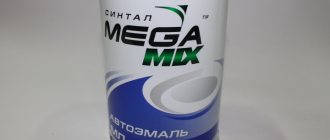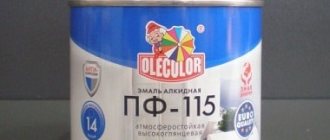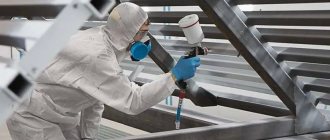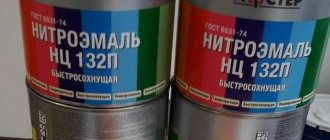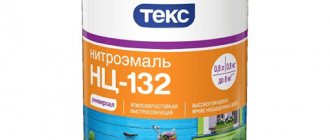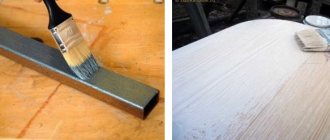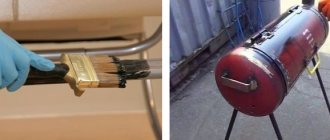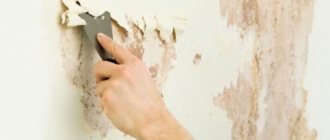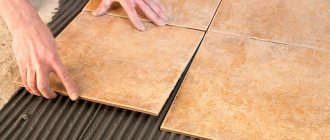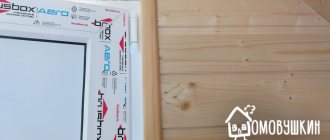Enamel paint PF-115 was developed back in the 1970s, and continues to be popular, despite the abundance of new paints and varnishes. This popularity is due to the operational and technical characteristics of PF-115 enamel: excellent adhesion to diverse surfaces, elasticity, decorative appearance, etc.
In terms of its chemical composition, PF-115 is a suspension of pigments, specialized fillers and modifiers in an alkyd mixture. The paint is based on pentaphthalic varnish. The explanation of the “PF-115” marking is as follows:
- PF - an indication of the pentaphthalic paint base;
- 1 – means that the material is weather-resistant (suitable for outdoor use);
- 15 is the number of this enamel in the paint and varnish catalogue.
The production of PF-115 paint is carried out in accordance with GOST 6465-76. White spirit is predominantly used as a solvent. The enamel of this brand has high hiding power and, after application, forms a uniform, smooth coating without unevenness or cracks.
Technical characteristics of paint PF-115
- Resistance to atmospheric and weather factors (precipitation, ultraviolet radiation, temperature changes, wind loads).
- Resistance to chemical influences: PF-115 paint can withstand the effects of fuels and lubricants for 24 hours, at least 2 hours - water, up to 15 minutes - aggressive detergents.
- Adhesion – about 1 point. There are also oil-based versions of enamel paint on sale that have less adhesion.
- Covering capacity – 80 ± 40 g/m2.
- The percentage of non-volatile components in enamel paint is in the range of 49–70% (depending on the paint manufacturer).
- Specific hardness – 0.15–0.25 conventional units.
- Viscosity – 90 ± 30 conventional units.
- Drying time - up to 24 hours under normal conditions (humidity up to 65% and temperature about 20 ° C). For cherry and red paint, drying time is up to 48 hours.
- Flexural elasticity is about 1 mm.
- Operating temperature range – from -50 to +60 °C.
3Classification
Products of the highest and first grade are produced - for all colors except red and cherry, which are produced only in 1 grade. This is due to the long drying time: 48 hours at a temperature of 20C, while the highest grade dyes dry to maximum hardness in 24 hours.
The difference between the highest and first grades is determined by one or more characteristics. If the gloss is below 60% but above 50%, or the film hardness is slightly below the optimal value, the grade is reduced. Protective properties are assessed: the ability to withstand moisture, oils, and cleaning solutions.
First-class products are cheaper, but when used under normal conditions, their aesthetic and protective properties are not much inferior to the highest category.
A total of 19 colors are produced. Among them are the classic colors of the spectrum, as well as white, black, and gray. You can purchase PF-115 enamel in additional shades: light yellow, beige and blue. gray-blue, pistachio, etc. It is possible to order an industrial batch of paint, the color of which differs from the standard list.
During the production process, paint is ensured to match standard color samples; control is performed in natural light.
Scope of application of PF-115 paint
High adhesion makes PF-115 enamel universal and provides the possibility of its use on various surfaces: metal, wood, brick, plaster, concrete, fiberboard, asbestos cement, plasterboard, chipboard, etc. This material is used:
- for interior work. PF-115 paint is used to paint wooden windows and doors, metal radiators and pipes, wall panels and other indoor surfaces;
- for outdoor work. The scope of application of PF-115 enamel includes painting fences, verandas, benches, outbuildings, and landscape decorative structures.
Please note: PF-115 paint is not abrasion resistant, so its use on floors and other surfaces subject to significant physical stress is not recommended.
What does the marking PF-115 mean?
The letters PF in the marking mean that its main component is pentaphthalic varnish.
It is a derivative of alkyd resins that are highly soluble in aliphatic solvents such as white spirit. It is due to these resins that the paint forms a protective film on the surface that is impenetrable to the physical and chemical influences of the external environment. Also, thanks to the pentaphthalic varnish, it has good covering ability. The number “1” following the letters means that the paint and varnish material is suitable for exterior finishing in a wide range of climatic conditions. According to regulatory documents, PF-115 can be used to coat wooden and metal surfaces indoors and outdoors, including those that are exposed to weather conditions.
The numbers “15” indicate the number of the chemical composition, which is established in state standards.
How to work with PF-115 enamel
Preparing the surface for applying PF-115 paint
Proper preparation helps prevent the formation of unevenness and peeling, and ensure a neat, decorative appearance of the surface. Main stages of work:
- cleaning Remove old paint, dust, grease and other contaminants from the surface. For this, use soda or soap solution, washing powder or other means (depending on the type of dirt). Clean metal surfaces from rust, and treat wooden surfaces with sandpaper. Pentaphthalic compounds can be applied over old paint, but the surface must be thoroughly sanded;
- drying. During the warm season, it is carried out naturally; in the cold season, heat guns can be used. Drying time depends on the material; pay special attention to drying porous surfaces (concrete, plaster);
- padding. The metal is treated with a degreasing compound, then with an anti-corrosion primer. A universal varnish, a specialized primer or drying oil is applied to the wood. Alkyd primers are suitable for porous materials.
Painting with PF-115 enamel
For painting, use the usual painting tools: rollers, brushes, brushes, spray guns. The choice of type and size of tools depends on the dimensions and configuration of the structures or surfaces to be processed. Small parts can be dip painted. The recommended temperature for applying PF-115 enamel is 5–35 °C. Work order:
- paint preparation. Open the jar, dilute the enamel with solvent if necessary, stir with a wooden stick until smooth;
- application. Distribute the paint evenly over the surface to be treated using a roller, brush or other tool of your choice;
- drying. Usually it is carried out under natural conditions. The process can be accelerated by using heat guns or other heating equipment (but the temperature of such processing should not exceed 100–110 ° C).
To ensure maximum quality, PF-115 enamel is applied in several layers. Each subsequent layer is applied after the previous one has dried, and the total amount depends on the nature of the surface:
- metal – at least 2 layers;
- concrete, brick, plaster, wood - 2–3 layers, each 20 ± 3 mm thick.
The color of the paint and its proximity to the shade of the surface being painted also matters.
Features of application on different types of surfaces
Let's take a closer look at how to properly apply paint to various types of surfaces.
Metal
Painting begins after the primer has completely dried . To prepare a metal surface, use compositions VL-05, GF-021 and other types of metal primers compatible with pentaphthalic varnish. Structures with traces of corrosion are additionally treated with rust converters immediately before priming.
Special products will slow down the oxidative processes in existing foci, convert loose oxides into solids and prevent the appearance of new foci of rust.
Tree
The technical characteristics of PF-115 enamel allow it to be applied without priming, but in 2-3 layers. It is recommended to pre-impregnate the wood with fire retardants, antiseptics, fungicides, and other protective agents that are not part of the enamel.
Mineral bases
Plaster, concrete, brick can be painted without priming. It is necessary to thoroughly dry the surface before starting work . Enamel forms a dense vapor-proof film, so residual moisture in the pores of the base can cause cracking at low temperatures, provoke mold growth, etc.
Fresh concrete walls, foundations, and other structures can be painted no earlier than six months after completion of construction.
Safety precautions when working with PF-115 paint
- Use personal respiratory and eye protection (respirator and goggles, respectively).
- Protect your hands: use gloves; if paint gets on your skin, immediately wash the area with warm water and soap.
- Take care of ventilation. It can be natural or artificial. If work is carried out indoors, the room must be ventilated upon completion of painting.
- Ensure fire safety: there should be no open sources of flame near the structure to be painted.
- Observe storage conditions. Since enamel is flammable, keep it away from sources of fire. Provide protection from direct sunlight and high humidity.
5Technology of use, consumption
Before painting, you should prepare the surface: clean, degrease, prime. Primer GF-119, GF-021 is used. It is difficult to completely remove rust from iron, especially if the shape of the product is complex. The Unicor modifier helps get rid of tight-fitting rust. It is applied after loose iron oxides have been removed.
Before starting work, check the viscosity of the paint and, if necessary, add a solvent - white spirit. It is allowed to add 20% of the diluent in relation to the total volume.
The diluted enamel must be thoroughly mixed. to obtain a homogeneous suspension. For application use a sprayer, or a roller, or a brush. Small parts are painted by dipping them into paint.
To ensure effective protection against external influences, apply two or three layers. Subsequent painting is carried out after the previous one has completely dried.
Consumption depends on the condition of the surface and the viscosity of the paint and varies between 100-180g per m2.
Popular manufacturers of PF-115 paint
Many Russian brands are engaged in the production of PF-115 paint. The following brands are the most popular:
- Lakra.
- Tex.
- Leningrad paints.
- Optimum.
- Colorist.
- Super color.
There are two types of PF-115 on sale: for household and industrial purposes. The differences lie in the release form. Industrial formulations are concentrated and require the addition of solvents. Paints and varnishes for household use are produced ready for application. The need for dilution arises if the paint has thickened. When purchasing, pay attention to the presence of a certificate of conformity.
In what shades is PF-115 paint available?
According to GOST 6465-76, PF-115 enamel is available in more than 20 different colors. Depending on this, the type of coloring pigments that are added to the composition varies. For example, white enamel contains zinc white, blue enamel contains iron glaze, and gray enamel contains carbon black. There are also paintwork materials on sale in red, black, brown, yellow, green and other colors. Other shades can be obtained by mixing or coloring. Also pay attention to the gloss level: the resulting finish can be matte, glossy or semi-matte.
E mal PF-115: paint consumption per 1 m2: influence of shades
The solution may increase due to different light transmittance.
The more often a layer is applied, the greater the consumption. The surface itself plays a big role - if the soil is selected correctly, then the costs of the material are reduced.
In tropical climates, enamel remains stable for 12 months, in constant cold conditions up to 3-4 years. Consumption per 1 m2 is usually indicated on the can.
Paint consumption per 1 m2 of metal or other surfaces with a thickness of up to 23 microns is up to 180 g/m2 (0.18), you can see calculations for a specific color below.
PF-115 consumption per 1 m 2 of single-layer coating (calculation in kg):
- Up to 0.14 (red).
- Up to 0.06 (black, the most economical).
- Up to 0.1 (for blue).
- Up to 0.08 (for brown).
- Up to 0.14 (for white).
- Up to 0.11 (for gray color).
To determine the amount of another shade, you need to multiply the number first by the number of layers, and then by 0.9 (coefficient).
It should be taken into account that the subsequent layer is applied thinner, which means the consumption is less.
Enamel test PF-115 video
The main advantages of PF-115 enamel
- Moisture resistance. The coating withstands direct contact with water, precipitation, and protects the painted surface from corrosion.
- Economical. The consumption of enamel paint is 140 ± 40 g/m2 and depends on the method of application, type of surface, etc.
- Resistant to fading. PF-115 paint is resistant to ultraviolet rays, so the coating does not fade or fade.
- Resistance to chemical influences. This means that painted surfaces can be cleaned using detergents.
- Versatility. PF-115 is suitable for various surfaces, perfectly combined with decorative plaster, varnished wood, etc.
- Affordability. With its high technical characteristics, enamel paint PF-115 is inexpensive compared to many other paintwork materials.
Area of use
Thanks to its optimal technical parameters, PF-115 paint is universal in use for treating metal and wooden surfaces, as well as those made of concrete. The paint and varnish material is in demand for decorating walls, ceilings, heating system radiators, doors, window frames and other interior elements. Due to its weather resistance, the paint can be used without limitation for decorating external structures. Gazebos, garden benches, fences and various utility structures acquire a presentable appearance and reliable protection from the effects of destructive natural factors.
Painting wood with PF-115 paint
Due to the formation of a protective film on painted surfaces, swelling and peeling do not form when exposed to moisture. Resistance to fading in the sun allows you to maintain the original color and gloss for a long time. Therefore, PF-115 enamel is used to paint not only metal and wood structures, but also plasterboard, fiberboard, chipboard, brickwork, plaster and putty. The paint does not have bactericidal properties, so it can be combined with primers and antiseptics, as well as insulating materials.
Painting concrete surfaces
For industrial use, the paint and varnish material is in demand in the engineering, machine tool and other industries for the purpose of painting structures and metal structures. Reliably protects metal surfaces from corrosion. Due to its instability to abrasion, the paint is not recommended for painting floors and other surfaces that are subject to increased physical stress.
Painting of metal structures
Disadvantages of PF-115 enamel
- Fire hazard. This paint is flammable, so it must be protected from open flame sources.
- Characteristic smell. For this reason, and also because of some toxicity, it is necessary to ensure good ventilation when working with PF-115, use a respirator and other personal protective equipment.
- Drying time. The process lasts about a day, and at temperatures below 20 ° C it takes even longer, which not all users like.
- Difficulty in laundering. After drying, enamel paint PF-115 is difficult to remove, including from painting tools and work clothes.
How to apply primer
Before work, perform several mandatory steps:
- Clean the surface from any elements that could fall off, so prepare the painting area;
- Remove irregularities, cracks or chips, remove rust or dirt;
- Remove grease stains, old paint or wallpaper.
It is also worth making sure that the temperature is suitable for using the primer, otherwise it will take a long time to dry after painting or will quickly peel off.
Apply the primer using special tools. Most often, a roller and brush are used for this. A brush is useful in cases where the area that needs to be painted is small. The roller is already used for a large range of work. Buy a special tray for it - this will facilitate and speed up the process and reduce primer consumption.
Roller painting
The primer is also applied using a pneumatic spray gun. With it, painting will be completed much faster and with better quality. But for one-time, small work there is no need for it.
If the primer is applied to metal, take into account that its consumption is approximately 140 g per square meter, since it is applied in two layers.
